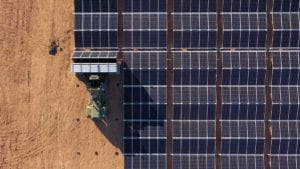A solar plant and battery storage system operating on Lord Howe Island in the Tasman Sea has just hit its six month milestone, its developer says and will help the small island community slash its reliance on diesel power by two-thirds.
Lord Howe Island, located 700-kilometres north-east out to sea from Sydney, is a UNESCO World Heritage Site located in the Tasman Sea between Australia and New Zealand, and is largely self-sufficient for its own energy needs.
Given its remote location, the ground-mounted solar PV and Tesla Powerpack system was designed specifically for the island and is integrated with the local microgrid and diesel generators which were previously the main source of power for the island community.
‘The announcement of this project is a fantastic result for the Lord Howe Island community and visitors alike,” said Mick Pettitt, acting CEO of the Lord Howe Island Board.
“We are reducing the environmental impact of our energy supply while also improving energy security. Achieving this without detracting from the World Heritage values of Lord Howe Island is a result that everyone should celebrate.”
Demonstrating the reliability of solar PV technology partnered with battery storage, the system successfully navigated stretches of up to five days and nights in August without any additional diesel-generated power.
The project had originally been designed with a wind turbine in mind, with the original proposal to include two wind turbines with a total capacity of 550kW. However, the wind turbines were ruled out when then environment and energy minister Josh Frydenberg stepped in to ban their use.
The eventual plant consists of 3,240 photovoltaic modules with a combined capacity of 1.3MW and a Tesla Powerpack battery energy storage system with a capacity of 3.7MWh, and the power system is managed by a Tesla Microgrid Controller.
Completed over a 14-month period after work began in February of 2020, the project received $4.5 million in funding from the Australian Renewable Energy Agency, while the Lord Howe Island Board secured a NSW Government loan of $5.9 million, providing the remaining balance of funds from its own capital.
‘We are very pleased with the success of this project for the Lord Howe Island community,” said Michael Gartner, CTO of Photon Energy Group and Managing Director of Photon Energy Australia.
“The experience we have gained through the delivery of the project demonstrates that solar power and energy storage not only reduce emissions and other environmental risks but are instrumental in ensuring energy security.”
The $11.1 million project was funded by the Lord Howe Island Board and the Australian Renewable Energy Agency (ARENA) and developed by Photon Energy Engineering Australia, a subsidiary of the Amsterdam-headquartered Photon Energy Group.








